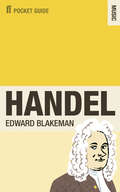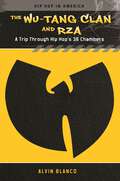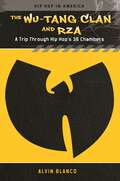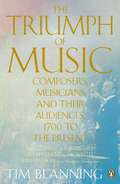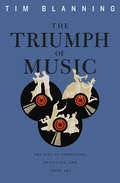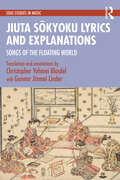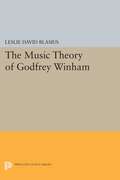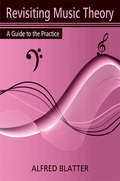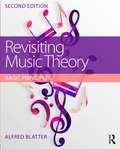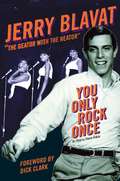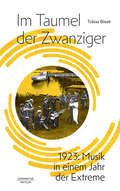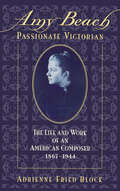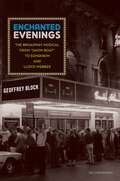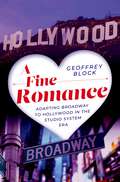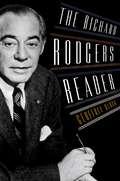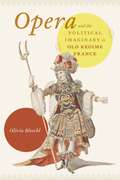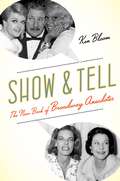- Table View
- List View
The Faber Pocket Guide to Handel
by Edward BlakemanThe Faber Pocket Guide to Handel offers a detailed but accessible exploration of George Frederick Handel, his composition, and his legacy. A larger-than-life figure in his time, Handel's reputation has been less than steady since his death in 1759. Was he (in the words of Berlioz) just 'a great barrel of pork and beer', or (as Handel himself claimed) truly 'the master of us all'? Now, more than 250 years after his death, there is more interest in Handel than ever before, with his operas (such as Rinaldo and Agrippina) experiencing fantastic renewed popularity. This lively new Pocket Guide goes in search of the composer who wrote the Messiah, Water Music - and much more.Handy for browsing and reference, key features include:- Handel's life: year by year- Handel's operas: a complete guide- Essential Handel- Picturing Handel- Handel on CD and DVD- Handel OnlineEdward Blakeman assesses how Handel's works - incredibly influential in their context of baroque music - have stood the test of time and why they can still speak thrillingly to us today. With recommendations throughout for listening, further reading, and web surfing, this is the ideal guide for music lovers who want to discover the great composer for themselves.
The Wu-Tang Clan and RZA: A Trip through Hip Hop's 36 Chambers (Hip Hop in America)
by Alvin BlancoThis insightful biography looks at the turbulent lives, groundbreaking music and lyrics, and powerful brand of hip hop's infamous Wu-Tang Clan.The Wu-Tang Clan and RZA: A Trip through Hip Hop's 36 Chambers chronicles the rise of the Wu-Tang Clan from an underground supergroup to a globally recognized musical conglomerate. Enhanced by the author's one-on-one interviews with group members, the book covers the entire Wu-Tang Clan catalog of studio albums, as well as albums that were produced or heavily influenced by producer/rapper RZA. Wu-Tang Clan's albums are analyzed and discussed in terms of their artistry as well as in terms of their critical, cultural, and commercial impact. By delving into the motivation behind the creation of pivotal songs and albums and mining their dense metaphor and wordplay, the book provides an understanding of what made a team of nine friends and relatives from Staten Island with a love of Kung Fu movies into not just a music group, but a powerful cultural movement.
The Wu-Tang Clan and RZA: A Trip through Hip Hop's 36 Chambers (Hip Hop in America)
by Alvin BlancoThis insightful biography looks at the turbulent lives, groundbreaking music and lyrics, and powerful brand of hip hop's infamous Wu-Tang Clan.The Wu-Tang Clan and RZA: A Trip through Hip Hop's 36 Chambers chronicles the rise of the Wu-Tang Clan from an underground supergroup to a globally recognized musical conglomerate. Enhanced by the author's one-on-one interviews with group members, the book covers the entire Wu-Tang Clan catalog of studio albums, as well as albums that were produced or heavily influenced by producer/rapper RZA. Wu-Tang Clan's albums are analyzed and discussed in terms of their artistry as well as in terms of their critical, cultural, and commercial impact. By delving into the motivation behind the creation of pivotal songs and albums and mining their dense metaphor and wordplay, the book provides an understanding of what made a team of nine friends and relatives from Staten Island with a love of Kung Fu movies into not just a music group, but a powerful cultural movement.
The Triumph of Music: Composers, Musicians and Their Audiences, 1700 to the Present (Penguin Modern Classics)
by Tim BlanningOnce musicians such as Mozart were little more than court servants; now they are multimillionaire superstars wielding more power than politicians. How did this extraordinary change come about? Tim Blanning's brilliantly enjoyable book examines how everything from the cult of the romantic to technology and travel all fed the inexorable rise of music in the West, making it the most dominant and ubiquitous of the art forms. Encompassing balladeers, the great composers, jazz legends and rock gods, this is an enthralling story of power, patronage, creativity and genius.
The Triumph of Music: The Rise of Composers, Musicians and Their Art
by Tim BlanningA distinguished historian chronicles the rise of music and musicians in the West from lowly balladeers to masters employed by fickle patrons, to the great composers of genius, to today’s rock stars. How, he asks, did music progress from subordinate status to its present position of supremacy among the creative arts? Mozart was literally booted out of the service of the Archbishop of Salzburg “with a kick to my arse,” as he expressed it. Yet, less than a hundred years later, Europe’s most powerful ruler—Emperor William I of Germany—paid homage to Wagner by traveling to Bayreuth to attend the debut of The Ring. Today Bono, who was touted as the next president of the World Bank in 2006, travels the world, advising politicians—and they seem to listen. The path to fame and independence began when new instruments allowed musicians to showcase their creativity, and music publishing allowed masterworks to be performed widely in concert halls erected to accommodate growing public interest. No longer merely an instrument to celebrate the greater glory of a reigning sovereign or Supreme Being, music was, by the nineteenth century, to be worshipped in its own right. In the twentieth century, new technological, social, and spatial forces combined to make music ever more popular and ubiquitous. In a concluding chapter, Tim Blanning considers music in conjunction with nationalism, race, and sex. Although not always in step, music, society, and politics, he shows, march in the same direction.
Jiuta Sōkyoku Lyrics and Explanations: Songs of the Floating World (ISSN)
by Christopher Yohmei Blasdel Gunnar Jinmei LinderJiuta Sōkyoku Lyrics and Explanations is a compendium of seventy-three representative songs from the well-known genre of traditional Japanese Edo-period sankyoku ensemble music.Including extensive annotations along with commentaries and notes on their musical and performative aspects, the collection begins with an overview which traces the history of the jiuta sōkyoku genre and the various socio-political influences at work in its formation. The translations and analyses are followed by a substantive glossary and bibliography, allowing for a deeper understanding of both the literary and musical aspects of jiuta sōkyoku compositions.Jiuta Sōkyoku Lyrics and Explanations is a comprehensive anthology that will be of great interest to researchers, including ethnomusicologists, Japanese studies scholars and poetry lovers who are fascinated with the literary and musical impact of the Edo period.
The Music Theory of Godfrey Winham
by Leslie David BlasiusThis book serves as an introduction to the work of Godfrey Winham, an influential figure in American music theory circles in the 1960s. Little published in his lifetime, Winham left behind, at his premature death in 1974, a massive collection of notes: correspondence, unfinished articles, sketches for books, etc. These notes were transcribed and deposited in the Special Collections of Firestone Library at Princeton University. They cover a fascinating range of subjects: exercises in analytical logic, thoughts on the construction of a formally consistent music theory, studies of particular pieces, and an epistemological reconception of Schenker's analysis.In The Music Theory of Godfrey Winham, Leslie David Blasius attempts to synthesize the various aspects of the theorist's thinking into a single coherent, if unfinished, endeavor. Blasius concentrates in particular on Winham's attempts to define formally the basic terms of music theory, his axiomatic phenomenology of pitch and harmonic relations, his tentative steps towards an axiomatic phenomenology of rhythm, and his fresh consideration of the reciprocal relationship between theory and analysis. In so doing, Blasius gives a clear picture of the materials in the archives, particularly when they exhibit Winham's multiple attempts to come to terms with a specific problem. The volume includes a set of complete excerpts of materials cited in Blasius's text and an index for the entire collection.Originally published in 1997.The Princeton Legacy Library uses the latest print-on-demand technology to again make available previously out-of-print books from the distinguished backlist of Princeton University Press. These editions preserve the original texts of these important books while presenting them in durable paperback and hardcover editions. The goal of the Princeton Legacy Library is to vastly increase access to the rich scholarly heritage found in the thousands of books published by Princeton University Press since its founding in 1905.
Revisiting Music Theory: A Guide to the Practice
by Alfred BlatterRevisiting Music Theory: A Guide to the Practice contains the basics of music theory with the vocabulary used in harmonic and formal analysis. The book assumes few music reading skills, and progresses to include the basic materials of music from J. S. Bach to the twentieth century. Based on Blatter’s own three decades of teaching music theory, this book is aimed at a one or two year introductory course in music theory, can serve for individual study, or as a review for graduate students returning to school. Drawing examples from well-known classical works, as well as folk and popular music, the book shows how theory is applied to practice. The book is divided into five parts. The first part introduces music notation, reviewing the basics of pitch, time, and dynamics as represented in written music. Part 2 introduces the concept of melody, covering modes, scales, scale degrees, and melodic form. Part 3 introduces harmony, dealing with harmonic progression, rhythm, and chord types. Part 4 addresses part writing and harmonic analysis. Finally, Part 5 addresses musical form, and how form is used to structure a composition. Revisiting Music Theory will be a valuable textbook for students, professors, and professionals.
Revisiting Music Theory: A Guide to the Practice
by Alfred BlatterRevisiting Music Theory: A Guide to the Practice contains the basics of music theory with the vocabulary used in harmonic and formal analysis. The book assumes few music reading skills, and progresses to include the basic materials of music from J. S. Bach to the twentieth century. Based on Blatter’s own three decades of teaching music theory, this book is aimed at a one or two year introductory course in music theory, can serve for individual study, or as a review for graduate students returning to school. Drawing examples from well-known classical works, as well as folk and popular music, the book shows how theory is applied to practice. The book is divided into five parts. The first part introduces music notation, reviewing the basics of pitch, time, and dynamics as represented in written music. Part 2 introduces the concept of melody, covering modes, scales, scale degrees, and melodic form. Part 3 introduces harmony, dealing with harmonic progression, rhythm, and chord types. Part 4 addresses part writing and harmonic analysis. Finally, Part 5 addresses musical form, and how form is used to structure a composition. Revisiting Music Theory will be a valuable textbook for students, professors, and professionals.
Revisiting Music Theory: Basic Principles
by Alfred BlatterRevisiting Music Theory: Basic Principles, Second Edition, surveys the basics of music theory and explains the terms used in harmonic and formal analysis in a clear and concise manner. Students will find Revisiting Music Theory to be an essential resource for review or reference, while instructors of introductory theory courses will find in these pages a solid foundation for cultivating musical thinking. Musicians of all kinds—amateur and professional alike—will find great value in augmenting and informing their knowledge of the art of music theory. The text covers the basic principles of music theory, including:• Musical notation• Key signatures and scales• Intervals, chords, and progressions• Melodic and harmonic analysis• Counterpoint and voice leading techniques• Musical forms and structures This second edition has been revised and reorganized to promote learning. Each section now includes an all-new selection of exercises, allowing readers to practice key skills and improve understanding. For students, instructors, and practicing musicians, Revisiting Music Theory offers an indispensable guide to the foundations of musical analysis.
Revisiting Music Theory: Basic Principles
by Alfred BlatterRevisiting Music Theory: Basic Principles, Second Edition, surveys the basics of music theory and explains the terms used in harmonic and formal analysis in a clear and concise manner. Students will find Revisiting Music Theory to be an essential resource for review or reference, while instructors of introductory theory courses will find in these pages a solid foundation for cultivating musical thinking. Musicians of all kinds—amateur and professional alike—will find great value in augmenting and informing their knowledge of the art of music theory. The text covers the basic principles of music theory, including:• Musical notation• Key signatures and scales• Intervals, chords, and progressions• Melodic and harmonic analysis• Counterpoint and voice leading techniques• Musical forms and structures This second edition has been revised and reorganized to promote learning. Each section now includes an all-new selection of exercises, allowing readers to practice key skills and improve understanding. For students, instructors, and practicing musicians, Revisiting Music Theory offers an indispensable guide to the foundations of musical analysis.
You Only Rock Once: My Life in Music
by Jerry BlavatJerry Blavat's rockin' life story pulses with celebrity names, infamous episodes and "offers readers an insider's view into the golden era of rock and roll and pop music and entertainment" raves Publishers Weekly. The long-awaited autobiography of entertainment icon Jerry Blavat, You Only Rock Once is the wildly entertaining and unfiltered story of the man whose career began at the age of 13 on the TV dance show Bandstand and became a music legend. Lifelong friendships with the likes of Sammy Davis Jr. and Frank Sinatra, a controversial relationship with Philadelphia Mafia boss Angelo Bruno that resulted in a decade-long FBI investigation, and much more colors this amazing journey from the early 60s through today. Now, some 50 years after his first radio gig, Blavat puts it all in perspective in this uniquely American tale of a "little cockroach kid" borne out of the immigrant experience who lived the American Dream.
Im Taumel der Zwanziger: 1923: Musik in einem Jahr der Extreme
by Tobias BleekIn den 1920er-Jahren gerät nicht nur die Welt, sondern auch die Musik und das Musikleben ins Taumeln: zwischen Krise und Krieg, Abschottung und Austausch, dem resignativen Blick zurück und neuer Dynamik. Wie eng Musik und Gesellschaft miteinander verflochten sind, zeigt das Jahr 1923. Geprägt ist es durch Geschehnisse, Debatten und Entwicklungen, die uns auch heute noch beschäftigen.Im besetzten Ruhrgebiet wird Musik zu einem Mittel des politischen Kampfes; in der von der Hyperinflation erschütterten Weimarer Republik verschärft sich die Krise des Konzertlebens und der Kartenpreis steigt im Herbst auf 200 Milliarden Mark; in den USA machen afroamerikanische Blues- und Jazz-Größen wie Bessie Smith, oder Louis Armstrong im Rahmen der sogenannten „race records“ ihre ersten Schallplattenaufnahmen; In Wien vollendet Arnold Schönberg seine ersten zwölftönigen Werke; In Paris schockiert Igor Strawinsky die Avantgarde mit seinem neoklassizistischen Bläseroktett und in Budapest setzt Béla Bartók mit seiner Tanz-Suite ein musikalisches Zeichen gegen den Nationalismus. Im Berliner Voxhaus wird mit der Ausstrahlung der ersten Funkstunde auf dem Höhepunkt der politischen und ökonomischen Krise das Zeitalter des öffentlichen Rundfunks in Deutschland eingeläutet.- Das Buch von Tobias Bleek erzählt auf faszinierende Weise, wie die Musik in das kulturelle, gesellschaftliche und politische Leben dieses Jahres der Extreme eingebettet ist.
Amy Beach, Passionate Victorian: The Life and Work of an American Composer, 1867-1944
by Adrienne Fried BlockAmy Marcy Cheney Beach (1867-1944), the most widely performed composer of her generation, was the first American woman to succeed as a creator of large-scale art music. Her "Gaelic" Symphony, given its premiere by the Boston Symphony Orchestra in 1896, was the first work of its kind by an American woman to be performed by an American orchestra. Almost all of her more than 300 works were published soon after they were composed and performed, and today her music is finding new advocates and audiences for its energy, intensity, and sheer beauty. Yet, until now, no full-length critical biography of Beach's life or comprehensive critical overview of her music existed. This biography admirably fills that gap, fully examining the connections between Beach's life and work in light of social currents and dominant ideologies. Born into a musical family in Victorian times, Amy Beach started composing as a child of four and was equally gifted as a pianist. Her talent was recognized early by Boston's leading musicians, who gave her unqualified support. Although Beach believed that the life of a professional musician was the only life for her, her parents had raised her for marriage and a career of amateur music-making. Her response to this parental (and later spousal) opposition was to find creative ways of reaching her goal without direct confrontation. Discouraged from a full-scale concert career, she instead found her métier in composition. Success as a composer of art songs came early for Beach: indeed, her songs outsold those of her contemporaries. Nevertheless, she was determined to separate her work from the genteel parlor music women were writing in her day by creating large-scale works--a Mass, a symphony, and chamber music--that challenged the accepted notion that women were incapable of creating high art. She won the respect of colleagues and the allegiance of audiences. Many who praised her work, however, considered her an exception among women. Beach's reaction to this was to join with other women composers of serious music by promoting their works along with her own. Adrienne Fried Block has written a biography that takes full account of issues of gender and musical modernism, considering Beach in the contexts of her time and of her composer contemporaries, both male and female. Amy Beach, Passionate Victorian will be of great interest to students and scholars of American music, and to music lovers in general.
Enchanted Evenings: The Broadway Musical from 'Show Boat' to Sondheim and Lloyd Webber
by Geoffrey BlockThis new second edition of Enchanted Evenings offers theater lovers an illuminating behind-the-scenes tour of some of America's best loved, most admired, and most enduring musicals. Readers will find such all-time favorites as Show Boat, Carousel, Kiss Me, Kate, Guys and Dolls, My Fair Lady, West Side Story, Sweeney Todd, Sunday in the Park with George, and Phantom of the Opera. Geoffrey Block provides a documentary history of each of the musicals, showing how each work took shape and revealing, at the same time, how the American musical evolved from the 1920s to today, both on stage and on screen. The book's particular focus is on the music, offering a wealth of detail about how librettist, lyricist, composer, and director work together to shape the piece. Block also includes trenchant social commentary and lively backstage anecdotes. Jerome Kern, Cole Porter, the Gershwins, Rodgers and Hart, Kurt Weill, Rodgers and Hammerstein, Lerner and Loewe, Frank Loesser, Leonard Bernstein, Stephen Sondheim, Andrew Lloyd Webber, and other luminaries emerge as hardworking craftsmen under enormous pressure to sell tickets without compromising their dramatic vision. The second edition includes a greatly expanded chapter on Sondheim, a new chapter on Lloyd Webber, and two new chapters on the film adaptations of the main musicals featured in the text (including such hard to find films as the original 1936 version of Anything Goes and the 1959 film adaptation of Porgy and Bess). Packed with information, including a complete discography and plot synopses and song-by-song scenic outlines for each of the fourteen shows, Enchanted Evenings is an essential reference as well as a riveting history. "A solid and fascinating work that should become a model of how to investigate and report on the evolution of a musical. Block's research is persuasive and his writing vivid. . . Indispensable for anyone who cares to know more about Broadway musicals than Playbill can provide." --Steven Bach, The Los Angeles Times Book Review
Enchanted Evenings: The Broadway Musical from 'Show Boat' to Sondheim and Lloyd Webber
by Geoffrey BlockThis new second edition of Enchanted Evenings offers theater lovers an illuminating behind-the-scenes tour of some of America's best loved, most admired, and most enduring musicals. Readers will find such all-time favorites as Show Boat, Carousel, Kiss Me, Kate, Guys and Dolls, My Fair Lady, West Side Story, Sweeney Todd, Sunday in the Park with George, and Phantom of the Opera. Geoffrey Block provides a documentary history of each of the musicals, showing how each work took shape and revealing, at the same time, how the American musical evolved from the 1920s to today, both on stage and on screen. The book's particular focus is on the music, offering a wealth of detail about how librettist, lyricist, composer, and director work together to shape the piece. Block also includes trenchant social commentary and lively backstage anecdotes. Jerome Kern, Cole Porter, the Gershwins, Rodgers and Hart, Kurt Weill, Rodgers and Hammerstein, Lerner and Loewe, Frank Loesser, Leonard Bernstein, Stephen Sondheim, Andrew Lloyd Webber, and other luminaries emerge as hardworking craftsmen under enormous pressure to sell tickets without compromising their dramatic vision. The second edition includes a greatly expanded chapter on Sondheim, a new chapter on Lloyd Webber, and two new chapters on the film adaptations of the main musicals featured in the text (including such hard to find films as the original 1936 version of Anything Goes and the 1959 film adaptation of Porgy and Bess). Packed with information, including a complete discography and plot synopses and song-by-song scenic outlines for each of the fourteen shows, Enchanted Evenings is an essential reference as well as a riveting history. "A solid and fascinating work that should become a model of how to investigate and report on the evolution of a musical. Block's research is persuasive and his writing vivid. . . Indispensable for anyone who cares to know more about Broadway musicals than Playbill can provide." --Steven Bach, The Los Angeles Times Book Review
A Fine Romance: Adapting Broadway to Hollywood in the Studio System Era
by Geoffrey BlockHow do we compare a Broadway musical to its Hollywood counterpart? A Fine Romance: Adapting Broadway to Hollywood in the Studio System Era answers this question by exploring the symbiotic relationship between a dozen Broadway musicals and their Hollywood film adaptations. From enduring classics like Oklahoma!, Brigadoon, and West Side Story to lesser-known gems such as Cabin in the Sky, Call Me Madam, and Silk Stockings, author Geoffrey Block examines some of the best loved stage and screen musicals of all time as well as neglected works that deserve our attention and respect. Block delves into what happens during the transfer of stories from stage to film, the critical criteria that motivates decisions to alter or preserve stage elements when adapting to film, and the dramatic and musical consequences at play in these artistic and commercial choices. In telling this story, A Fine Romance engages with aesthetic and critical concerns while also considering the social issues around Broadway and Hollywood film through the lenses of race and ethnicity, class, gender, and sexual identity. Beginning with the stage debut of Show Boat in 1927 and concluding with the release of Bob Fosse's cinematic re-envisioning of Cabaret nearly a half century later in 1972, the romance between Broadway and Hollywood was frequently turbulent. Differing commercial and aesthetic models and goals of Broadway and Hollywood created both conflicting and harmonious collaborations. Attempts at economic and artistic domination, irreconcilable differences, and occasional broken promises ensued. At other times, the screen and stage creative teams aligned, resulting in well-crafted, much admired, and frequently breathtaking films.
A Fine Romance: Adapting Broadway to Hollywood in the Studio System Era
by Geoffrey BlockHow do we compare a Broadway musical to its Hollywood counterpart? A Fine Romance: Adapting Broadway to Hollywood in the Studio System Era answers this question by exploring the symbiotic relationship between a dozen Broadway musicals and their Hollywood film adaptations. From enduring classics like Oklahoma!, Brigadoon, and West Side Story to lesser-known gems such as Cabin in the Sky, Call Me Madam, and Silk Stockings, author Geoffrey Block examines some of the best loved stage and screen musicals of all time as well as neglected works that deserve our attention and respect. Block delves into what happens during the transfer of stories from stage to film, the critical criteria that motivates decisions to alter or preserve stage elements when adapting to film, and the dramatic and musical consequences at play in these artistic and commercial choices. In telling this story, A Fine Romance engages with aesthetic and critical concerns while also considering the social issues around Broadway and Hollywood film through the lenses of race and ethnicity, class, gender, and sexual identity. Beginning with the stage debut of Show Boat in 1927 and concluding with the release of Bob Fosse's cinematic re-envisioning of Cabaret nearly a half century later in 1972, the romance between Broadway and Hollywood was frequently turbulent. Differing commercial and aesthetic models and goals of Broadway and Hollywood created both conflicting and harmonious collaborations. Attempts at economic and artistic domination, irreconcilable differences, and occasional broken promises ensued. At other times, the screen and stage creative teams aligned, resulting in well-crafted, much admired, and frequently breathtaking films.
The Richard Rodgers Reader (Readers on American Musicians)
by Geoffrey BlockRichard Rodgers was one of America's most prolific and best-loved composers. A world without "My Funny Valentine," "The Lady is a Tramp," "Blue Moon," and "Bewitched," to name just a few of the songs he wrote with Lorenz Hart, is scarcely imaginable, and the musicals he wrote with his second collaborator, Oscar Hammerstein--Oklahoma!, Carousel, South Pacific, The King and I, and The Sound of Music--continue to enchant and entertain audiences. Arranged in four sections, Rodgers and Hart (1929-1943), Rodgers and Hammerstein (1943-1960), Rodgers After Hammerstein (1960-1979), and The Composer Speaks (1939-1971), The Richard Rodgers Reader offers a cornucopia of informative, perceptive, and stylish biographical and critical overviews. It also contains a selection of Rodgers's letters to his wife Dorothy in the 1920s, the 1938 Time magazine cover story and New Yorker profiles in 1938 and 1961, and essays and reviews by such noted critics as Brooks Atkinson, Eric Bentley, Leonard Bernstein, Lehman Engel, Walter Kerr, Ken Mandelbaum, Ethan Mordden, George Jean Nathan, and Alec Wilder. The volume features personal accounts by Richard Adler, Agnes de Mille, Joshua Logan, Mary Martin, and Diahann Carroll. The collection concludes with complete selections from more than thirty years of Rodgers's own writings on topics ranging from the creative process, the state of the Broadway theater, even Rodgers's bout with cancer, and a generous sample from the candid and previously unpublished Columbia University interviews. For anyone wishing to explore more fully the life and work of a composer whose songs and musicals have assumed a permanent--and prominent--place in American popular culture, The Richard Rodgers Reader will offer endless delights.
Opera and the Political Imaginary in Old Regime France
by Olivia BloechlFrom its origins in the 1670s through the French Revolution, serious opera in France was associated with the power of the absolute monarchy, and its ties to the crown remain at the heart of our understanding of this opera tradition (especially its foremost genre, the tragédie en musique). In Opera and the Political Imaginary in Old Regime France, however, Olivia Bloechl reveals another layer of French opera’s political theater. The make-believe worlds on stage, she shows, involved not just fantasies of sovereign rule but also aspects of government. Plot conflicts over public conduct, morality, security, and law thus appear side-by-side with tableaus hailing glorious majesty. What’s more, opera’s creators dispersed sovereign-like dignity and powers well beyond the genre’s larger-than-life rulers and gods, to its lovers, magicians, and artists. This speaks to the genre’s distinctive combination of a theological political vocabulary with a concern for mundane human capacities, which is explored here for the first time. By looking at the political relations among opera characters and choruses in recurring scenes of mourning, confession, punishment, and pardoning, we can glimpse a collective political experience underlying, and sometimes working against, ancienrégime absolutism. Through this lens, French opera of the period emerges as a deeply conservative, yet also more politically nuanced, genre than previously thought.
Opera and the Political Imaginary in Old Regime France
by Olivia BloechlFrom its origins in the 1670s through the French Revolution, serious opera in France was associated with the power of the absolute monarchy, and its ties to the crown remain at the heart of our understanding of this opera tradition (especially its foremost genre, the tragédie en musique). In Opera and the Political Imaginary in Old Regime France, however, Olivia Bloechl reveals another layer of French opera’s political theater. The make-believe worlds on stage, she shows, involved not just fantasies of sovereign rule but also aspects of government. Plot conflicts over public conduct, morality, security, and law thus appear side-by-side with tableaus hailing glorious majesty. What’s more, opera’s creators dispersed sovereign-like dignity and powers well beyond the genre’s larger-than-life rulers and gods, to its lovers, magicians, and artists. This speaks to the genre’s distinctive combination of a theological political vocabulary with a concern for mundane human capacities, which is explored here for the first time. By looking at the political relations among opera characters and choruses in recurring scenes of mourning, confession, punishment, and pardoning, we can glimpse a collective political experience underlying, and sometimes working against, ancienrégime absolutism. Through this lens, French opera of the period emerges as a deeply conservative, yet also more politically nuanced, genre than previously thought.
Opera and the Political Imaginary in Old Regime France
by Olivia BloechlFrom its origins in the 1670s through the French Revolution, serious opera in France was associated with the power of the absolute monarchy, and its ties to the crown remain at the heart of our understanding of this opera tradition (especially its foremost genre, the tragédie en musique). In Opera and the Political Imaginary in Old Regime France, however, Olivia Bloechl reveals another layer of French opera’s political theater. The make-believe worlds on stage, she shows, involved not just fantasies of sovereign rule but also aspects of government. Plot conflicts over public conduct, morality, security, and law thus appear side-by-side with tableaus hailing glorious majesty. What’s more, opera’s creators dispersed sovereign-like dignity and powers well beyond the genre’s larger-than-life rulers and gods, to its lovers, magicians, and artists. This speaks to the genre’s distinctive combination of a theological political vocabulary with a concern for mundane human capacities, which is explored here for the first time. By looking at the political relations among opera characters and choruses in recurring scenes of mourning, confession, punishment, and pardoning, we can glimpse a collective political experience underlying, and sometimes working against, ancienrégime absolutism. Through this lens, French opera of the period emerges as a deeply conservative, yet also more politically nuanced, genre than previously thought.
Opera and the Political Imaginary in Old Regime France
by Olivia BloechlFrom its origins in the 1670s through the French Revolution, serious opera in France was associated with the power of the absolute monarchy, and its ties to the crown remain at the heart of our understanding of this opera tradition (especially its foremost genre, the tragédie en musique). In Opera and the Political Imaginary in Old Regime France, however, Olivia Bloechl reveals another layer of French opera’s political theater. The make-believe worlds on stage, she shows, involved not just fantasies of sovereign rule but also aspects of government. Plot conflicts over public conduct, morality, security, and law thus appear side-by-side with tableaus hailing glorious majesty. What’s more, opera’s creators dispersed sovereign-like dignity and powers well beyond the genre’s larger-than-life rulers and gods, to its lovers, magicians, and artists. This speaks to the genre’s distinctive combination of a theological political vocabulary with a concern for mundane human capacities, which is explored here for the first time. By looking at the political relations among opera characters and choruses in recurring scenes of mourning, confession, punishment, and pardoning, we can glimpse a collective political experience underlying, and sometimes working against, ancienrégime absolutism. Through this lens, French opera of the period emerges as a deeply conservative, yet also more politically nuanced, genre than previously thought.
Show and Tell: The New Book of Broadway Anecdotes
by Ken BloomDid you know that Frank Sinatra was nearly considered for the original production of Fiddler on the Roof? Or that Jerome Robbins never choreographed the famous "Dance at the Gym" in West Side Story? Or that Lin-Manuel Miranda called out an audience member on Twitter for texting during a performance of Hamilton (the perpetrator was Madonna)? In Show and Tell: The New Book of Broadway Anecdotes, Broadway aficionado-in-chief Ken Bloom takes us on a spirited spin through some of the most intriguing factoids in show business, offering up an unconventional history of the theatre in all its idiosyncratic glory. From the cantankerous retorts of George Abbott to the literally show-stopping antics of Katharine Hepburn, you'll learn about the adventures and star turns of some of the Broadway's biggest personalities, and discover little-known tidbits about beloved plays and musicals from The Black Crook to Beautiful.
Show and Tell: The New Book of Broadway Anecdotes
by Ken BloomDid you know that Frank Sinatra was nearly considered for the original production of Fiddler on the Roof? Or that Jerome Robbins never choreographed the famous "Dance at the Gym" in West Side Story? Or that Lin-Manuel Miranda called out an audience member on Twitter for texting during a performance of Hamilton (the perpetrator was Madonna)? In Show and Tell: The New Book of Broadway Anecdotes, Broadway aficionado-in-chief Ken Bloom takes us on a spirited spin through some of the most intriguing factoids in show business, offering up an unconventional history of the theatre in all its idiosyncratic glory. From the cantankerous retorts of George Abbott to the literally show-stopping antics of Katharine Hepburn, you'll learn about the adventures and star turns of some of the Broadway's biggest personalities, and discover little-known tidbits about beloved plays and musicals from The Black Crook to Beautiful.
